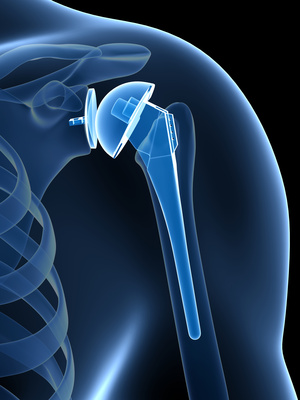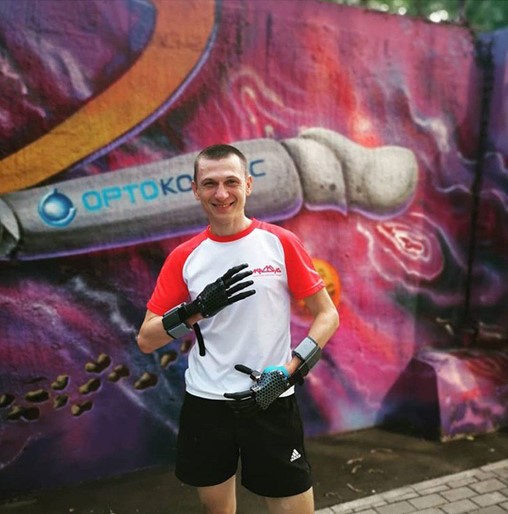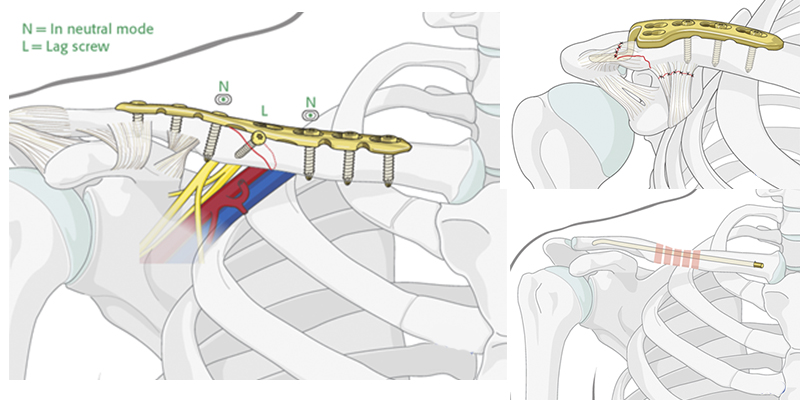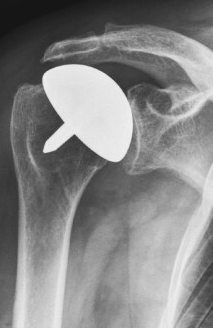Prostheses are often required as osteoarthritis of the shoulder progresses, when wear and tear on the articular cartilage surface (primary osteoarthritis) causes severe pain and severe limitation of movement.

- Bionic prosthetic hands available in Russia
- Touch Bionic by OSSUR
- i-limb access prosthetic arm
- i-limb ultra hand prosthesis
- Cybernetic i-limb hand in quantum form
- How the process works
- Osteosynthesis in fractures of the clavicle
- Types of tendon injuries
- tendon surgery
- How does the MRI scan of the shoulder work?
- Where can I have an arthroplasty?
- Types of shoulder arthroplasty
- Effectiveness of shoulder joint replacement surgery
- Principles of joint care
- How is a shoulder joint prosthesis used?
- Stages of shoulder endoprosthesis surgery
- Technical details of fixation insertion and removal
- Indications for the removal of retaining structures
- Preoperative Diagnosis
- Shoulder arthroplasty in Russian hospitals
- Total shoulder joint replacement
- hemarthroplasty
Bionic prosthetic hands available in Russia
More than seventy thousand amputations are performed in Russia every year: five hundred procedures per million population. This is the highest rate in the world. Amputations are caused by trauma, congenital and acquired diseases. The absence of a hand severely limits a person; without an assistant, he is unable to perform the simplest tasks. In addition to the physical suffering, the loss of a limb also causes psychological discomfort.
Important!!! In order for the prosthetic fitting to be successful, the amputation must be forgiven. Don't dwell on the problem, but don't avoid anything related to it either. The event has already taken place. It is irreversible. They have to adapt to the changed living conditions. The right attitude and a positive attitude towards the forthcoming prosthesis fitting increase the success of the rehabilitation.
Talking to people who have gone through this phase can help you to prepare well for the prosthesis fitting. A positive example is encouraging and motivating and makes you realize that you need to make an effort to return to normal life.
There are several fundamentally different types of prosthetic hands.
- Active prosthesis (pull prosthesis) You can learn some precise movements. You can learn to write with a pen or use cutlery. The prosthesis must be handled carefully so as not to damage the aesthetic shell; the straps of the drawstring can constrict.
- Working prosthesis The costs are low. The residual limb is equipped with an adapter shaft to which various working attachments can be attached, which need to be changed for changing activities. This offers high functionality, but the prosthesis does not look natural.
- Bionic prostheses – are the most advanced born from the meeting of three sciences: robotics, mechanics and biology. They come as close as possible to the function of the human hand and significantly improve the quality of life. Thanks to them, people are able to cope with such complex tasks as cooking, tying shoelaces, drawing or computer work. The disadvantages of bionic hands include their high cost. On the other hand, they are more expensive: they are able to perform everyday tasks that humans need.
Touch Bionic by OSSUR

choice of hands i-limb Touch Bionic The i-limb Touch Bionics range includes three different models, all of which fully help. All i-limb brushes have a comfortable grip and feature a separate motion for each finger and thumb twist. A unique software helps to set the different grip types precisely and to adjust them during the operation of the prosthesis. All available grip options are shown in the mobile electronic app.
i-limb access prosthetic arm
Bionic arm prosthesis i-limb access is controlled by muscles. Advanced software reads muscle-specific signals (triggers), selects and executes a specific automatic grip. This includes 12 different preset grip types that provide additional precision in the movement. A speed boost function ensures a more natural hand movement.
i-limb ultra hand prosthesis
The 'i-limb ultra' prosthetic hand has all the accessibility features of the i-limb, but 14 different grip types are already pre-programmed. In addition, there is a variable grip so that more force can be applied to the object if needed, and there is an automatic grip option to prevent the object from slipping. When the sensors detect a slip, the hand is automatically squeezed. Wrist flexion makes it easier to perform complex movements with greater precision, such as B. bringing a glass closer to the mouth.
Cybernetic i-limb hand in quantum form
Cybernetic hand prosthesis i-limb quantum enables the widest possible range of access control options, including gesture control. When the patient holds their hand in a certain position, the computer reads out the movement to be performed. Thumb rotation control is manual and automatic (selectable). The speed of the hand movement can be increased with one touch via a slider on the display (Quick Grip).
How the process works
The osteosynthesis operations in our clinic are minimally invasive (gentle) but highly effective procedures. Each operation goes through several standard steps:
- Anesthesia. Local or general anesthesia - depending on the situation.
- The surgeon makes a small incision sufficient for manipulation.
- Through this incision, the surgeon performs the necessary manipulation of the damaged bone parts with surgical instruments called fixators.
- Depending on the complexity, the operation lasts between 20 and 90 minutes. The incisions are sutured and a sterile bandage is applied.
Osteosynthesis in fractures of the clavicle
Surgical treatment is indicated for diaphyseal fractures of the clavicle, as well as some clavicle fractures with displacement and joint damage.
Simple oblique diaphyseal fractures are common fractures of the clavicle. They can be treated conservatively or surgically, depending on the dislocation and the patient's functional needs. Plate or intramedullary fixation is possible.
Intramedullary clavicle immobilization is preferred in young and very active patients who need to make a full recovery within a short time after surgery.
For displaced fractures, a hooked plate is typically used for immobilization. As a rule, such fixation is required for intra-articular fractures with a large number of fragments. A disadvantage of this method is that the plate must be removed after the bone has fully healed.

Types of tendon injuries
All tendon injuries can be divided into closed and open traumatic injuries. Subcutaneous tendon tears are the most common type of closed injury. Less common are tendon sprains, which usually occur in the outer part of the ankle (tendon sprain of the peroneal muscle).
Open tendon injuries occur in the following cases:
The most common injury to human tendon structures is tendon rupture. This pathology requires the most thorough diagnosis and, as a rule, surgical treatment.
A sports injury is often the cause of a tendon rupture. In such cases, improper treatment does not bring positive results or even worsens the patient's condition, so it may become impossible to continue a sports career.
tendon surgery
Depending on the type and location of the injury, the orthopedic surgeon selects the most appropriate treatment for the condition.
The main types of tendon injuries that can be treated today are
- tenorrhaphy (Sew the tendon with tendon sutures: nylon, silk, capron, thin tantalum wire).
- tendoplasty (Tissue replacement with implants for degenerative and inflammatory tendon injuries). There are three types of tendonoplasty: tendon autoplasty (the patient's own tissue is used as an implant), alloplasty (implants made from artificial materials), and xenoplasty (implants made from animal tissue).
- tenolysis – Removal of scars and adhesions from the tendon tissue;
- tenodesis – Surgical restriction of movement in a joint by fixing the tendon tissue in a specific position;
- tenotomy – Cutting tendons to lengthen them;
- transposition – Severing and reattachment of a tendon (this procedure is particularly indicated in the case of peripheral nerve damage).
How does the MRI scan of the shoulder work?
Photos and a detailed report from the diagnostician describing the condition of the shoulder joint
In the preparatory phase, the patient fills out forms and talks to the radiologist. If there are no contraindications, the person goes to the dressing room, leaving personal belongings, jewelry, metal objects and electronic devices. In the MRI room, you lie down on the MRI scanner platform and assume a comfortable position. An employee gives a short briefing and puts on headphones.
The doctor observes the main diagnostic phase through the glass from an adjoining room. The specialist monitors the sharpness of the images and, if necessary, asks the patient to perform certain actions. If contrast enhancement is needed, the exam is interrupted to give gadolinium. If the patient feels unwell, the examination can be interrupted at any time by informing the doctor of his or her symptoms via the loudspeaker or by pressing the panic button.
At the end of the examination, the radiologist decodes the images and creates a report. The patient receives this document along with a diskette containing the recordings. Based on the information from the report, the attending physician makes a diagnosis or adjusts the treatment.
Where can I have an arthroplasty?
NCC No. 2 (Central Clinical Hospital of the Russian Academy of Sciences) successfully restores the function of the upper limbs in patients in Moscow and the regions, performing the following procedures:
- replacement of finger joints;
- Wrist replacement surgery – hand endoprostheses (hand, wrist)
- arthroplasty (joint plastic) of the shoulder joint;
- Arthroplasty of the elbow joint.
Experienced surgeons perform minimally invasive operations under local anesthesia, after which the patient works with a rehabilitation therapist to regain normal mobility without pain and limitations as quickly as possible.
Endoprostheses for large joints and joints of the lower limbs are also performed at NCC No. 2 (Central Clinical Hospital of the Russian Academy of Sciences):
To find out more about the cost of the procedure or to arrange a consultation and examination, please call or use the online form on the clinic's website.
| Foot and toe endoprosthetics | 20000 rub. | ||
| Arthroplasty of the knee joint (arthroscopic) | 15000 rub. | ||
| Arthroplasty of the elbow joint | 30000 rub. | ||
| Unipolar Hip Arthroplasty (at no cost of medical supplies) | 30000 rub. | ||
| Shoulder Arthroplasty (without the cost of medical supplies) | 45000 rub. | ||
| Total Knee Arthroplasty (at no cost for medical supplies) | 55000 rub. | ||
| Total ankle replacement (without the cost of disposable supplies) | 55000 rub. | ||
| Revision Knee Arthroplasty (at no cost for disposables) | 700000 rub. | ||
| Revision hip arthroplasty (without the cost of disposable material) | 70000 rub. | ||
| Revision hip arthroplasty (without costs for disposable materials) | 30000 rub. | ||
| Hip prostheses due to acetabulum defects (without material costs) | 70,000 rubles | ||
| Finger and wrist prosthesis – one joint (without material costs) | 20000 rubles | ||
| Finger and wrist arthroplasty - two joints (no consumable cost) | 30000 rub. | ||
| Finger and wrist arthroplasty - three joints and more (without the cost of consumables) | 40000 rub. | ||
| Show all ↓ | |||
Types of shoulder arthroplasty

Shoulder joint arthroplasty or shoulder surface arthroplasty. Reconstruction of the surface of the humerus © Wikipedia
Hemiarthroplasty of the humerus or arthroplasty of the articular surface of the shoulder
In plate arthroplasty, only the cartilaginous surface of the humeral head is replaced. The bone of the humeral head is not removed. This type of prosthesis is used when the muscles that stabilize the shoulder joint (shoulder rotator cuff) are intact or only slightly damaged and the socket of the upper arm bone (glenoid) shows no signs of wear. With this type of prosthesis, the shoulder joint is restored by placing a metal surface on the top of the humeral head. The cartilage on the joint surface (glenoid) is preserved. Superficial shoulder arthroplasty preserves the intact or worn articular surface.
One of the main problems with superficial shoulder arthroplasty is the wear of the articular surface over time. Premature wear and tear of the articular surface can lead to increased pain and reduced mobility and resilience of the joint.
After shoulder hemiarthroplasty, the average improvement in range of motion is more than 40° in all directions. This clinical outcome is similar to the outcome after total shoulder arthroplasty. Before performing a superficial arthroplasty, the shoulder specialist must carefully assess the acetabular surface and ensure that it is in good enough condition for a successful outcome.
Effectiveness of shoulder joint replacement surgery
Total shoulder arthroplasty is a very effective shoulder surgery procedure. After shoulder replacement, the function, strength, and range of motion of the shoulder do not differ from those of a normal shoulder, provided the muscles and rotator cuff were intact prior to shoulder replacement.
The success rate of shoulder arthroplasty in the joint clinic is still very high, patient satisfaction is over 95%. The high qualification and specialization of our experienced doctors creates the conditions for an exact diagnosis and a successful shoulder replacement operation.
Principles of joint care
The treatment depends on the indication for the operation. The type of endoprosthesis required determines the scope and size of the operation.
There are two types of such implants:
- Partial Prosthesis – a circular component that replaces the head of the humerus;
- Total - replaces all elements of the joint (replaces the mobile and flat-concave part of the scapula).
The implants replicate the anatomical shape of the damaged joint. The size and characteristics of the joint are taken into account and the prosthesis is made individually for each patient.

How is a shoulder joint prosthesis used?
The patient must be in good health as this will help reduce recovery time as much as possible and reduce the risk of complications. Therefore, it is important to inform the doctor about all medical conditions, especially cardiovascular and urinary tract diseases. These problems are addressed before the arthroplasty.
Stages of shoulder endoprosthesis surgery
- The patient is placed under deep anesthesia.
- Incisions are made in the shoulder.
- Defective components are removed.
- The prosthesis is placed in the correct position, fused to the intramedullary canal and anchored with bone cement.
- The wound is sewn up.
The duration of the procedure is 1-3 hours. After the prosthesis has been inserted, the patient's arm is immobilized with a special fixation bandage.
Technical details of fixation insertion and removal
If the structure is correctly fixed externally, removal of the spokes after the fracture is not too difficult - the spokes are simply removed. Full surgery is required for intramedullary fixation with nails and screws within the joint.
Spiral fixation is used for fusion of limb and toe joints. It can be performed externally, raising the end of the spoke above the surface, or internally, with the entire structure under the skin. This technique is used as a temporary measure. In some cases where supracondylar fractures, clavicle fractures, or elbow injuries are being repaired, stable immobilization and a longer time to fusion are required.
For fractures of the shoulder, osteosynthesis techniques such as metal constructions, spokes and Ilizarov braces are used. These can only be removed again after complete healing.
Any bone can be fixed with plates. It is a convenient and reliable method. There are now many variants of these plates, which differ in size, shape and function. The plate is used in tibia and ankle fractures when bone fragments need to be immobilized. It is routinely removed. The timing of the operation is determined by the doctor.
Intramedullary pins are used to immobilize long bones, e.g. B. in the case of a broken collarbone or leg. The operation is quick and features minimal trauma. After immobilization, weight bearing is possible after just a few days.
Disassembly takes half an hour if done correctly. If threads or bolts are damaged, the components must be reamed.
Indications for the removal of retaining structures
On the one hand, the removal is an operation, on the other hand, a foreign body can cause unwanted reactions in the body. The device is used for a period of time while the bones heal. X-rays confirm that the fusion took place. The therapeutic technique is to remove the metal structure after the fracture to minimize the risk of developing deforming osteoarthritis.

Preoperative Diagnosis
In Russian clinics, before deciding on an operation, a thorough diagnosis is made. It is performed by an orthopedic surgeon and consists of several steps:
- Anamnese . The orthopedist will ask about your general health, the extent of your shoulder pain and how it is affecting your daily life.
- Physical examination . The doctor will assess the mobility, stability, and strength of the joint.
- Radiological Examination. It helps determine the extent of damage to the joint: narrowing of the joint space between bones, flattening or irregularity of bone heads, bone spurs, and pieces of cartilage or bone that can sometimes float in the joint.
- Other Investigations. Blood tests, CT scans, MRIs, or other additional diagnostic tests are sometimes needed to evaluate the condition of the bones or soft tissues in your shoulder.
Your doctor will review the diagnostic results with you and discuss the available arthroplasty options that are best suited to reduce pain and improve shoulder function.
Shoulder arthroplasty in Russian hospitals
Shoulder arthroplasty can be performed in different ways in clinics in Russia. Each of them has its own advantages. The choice is made based on the results of diagnostic tests.
Total shoulder joint replacement
During the operation, the damaged areas of the shoulder joint are replaced with endoprosthesis components - a ground metal ball connected to a stem and a plastic socket. These are connected to the bone in various ways: by being pressed into the bone or with bone cement. The first method is used when the bone quality is good, the second when the bone is soft.
A total replacement is not recommended if there is a significant deficit in the joint bone and an irreversible tear in the rotator cuff. Ideal candidates for surgery are people with osteoarthritis of the joint and an intact rotator cuff. The cost of replacing the shoulder joint in Russia using this method depends mainly on the type of implant used.
hemarthroplasty
Depending on the condition of your shoulder, surgeons in Russia may recommend replacing the humeral head yourself. During surgery, it is replaced with a metal ball and pin, which are endoprosthesis components similar to those used in total shoulder replacements.
In some cases, hemiarthroplasty is the surgery of choice when the humeral head is severely damaged and the acetabulum remains normal. Other indications for this type of arthroplasty are:
- Osteoarthritis with damage to the humeral head and normal socket
- instability of the joint
- Some cases of osteoarthritis and rotator cuff tears
Sometimes the surgeons choose a total arthroplasty or a hemiarthroplasty directly during the operation. The price of shoulder replacement in Russia is higher than that of hemiarthroplasty, but studies show that in patients with osteoarthritis, the first option has a better success rate in reducing pain.
Read more:- How much does a hip prosthesis cost?.
- How much does knee surgery cost?.
- How much does shoulder surgery cost?.
- How much does a prosthetic foot cost?.
- Modern leg prostheses.
- How much does a knee replacement cost?.
- Leg prosthesis below the knee.
- prosthetic legs.
